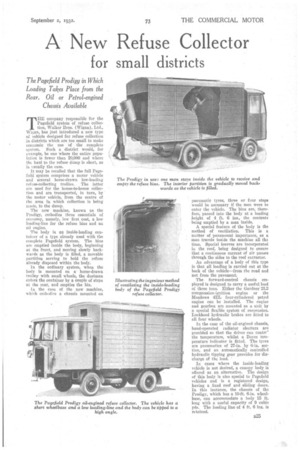A New Refuse Collector
Page 43

If you've noticed an error in this article please click here to report it so we can fix it.
for small districts
The Pagefield Prodigy in Which Loading Takes Place from the Rear. Oil or Petrol-engined Chassis Available
THE company responsible for the Pagefield system of refuse collection, Walker Bros. (Wigan), Ltd., Wigan, has just inttodueed a new type of vehicle designed for, refuse collection in districts which are too small to make economic the use of • the complete system. Such a district would, for example, be one where the entire population is fewer than 20,000 and where the haul to the refuse dump is short, as is usually the case.
lt may be recalled that the full Pagefield system comprises a motor vehicle and several horse-drawn low-loading refuse-collecting trollies.. The latter are used for the house-to-house dalleetion and ate transported, in turn, by the motor vehicle, from the centre of the area in which collection is being made, to the dump.
The new machine, known as the Prodigy, embodies three essentials of economy, namely, low first cost, a low loading-line for the refuse bins and an oil engine.
The body is an inside-loading container of a type already used with the complete Pagefield system.. The bins are emptied inside the body, beginning at the front, and moving slowly backwards as the body is filled, a movable partition serving to hold the refuse already disposed within the body.
In the ordinary system, when the body is mounted on a horse-drawn trolley with small wheels, the dustman enters the container by a couple of steps at the rear, and empties the bin.
To the case of the new machine, which embodies a chassis mounted on pneumatic tyres, three or four steps would be necessary if the men were to enter the vehicle. The bins are, therefore, passed into the body at a loading height of 4 ft. 6 ins., the contents being emptied by a man inside.
A special feature of the body is the method of ventilation, This is a matter of paramount importance, as a man travels inside the machine all th time. Special louvres are incorporated in the roof, being designed to ensure that a continuous current of air passes through the sides to the roof extractor.
An advantage of a body of this type is that all loading is carried out at the back of the vehicle—from the road and not from the pavement.
The forward-control chassis employed is designed to carry a useful load of three tons. Either the Gardner 21,2 compression-ignition engine or the Meadows 4EL four-cylindered petrol engine can be installed. The engine and gearbox are mounted as a unit by a special flexible system of suspension. Lockheed hydraulic brakes are fitted to all four wheels.
In the case of the oil-engined chassis, band-operated radiator shutters are provided so that the driver can centre the temperature, whilst a Boyce temperature indicator is fitted. The tyres
are pneumatics of 27-in. by section, and an automatically controlled hydraulic tipping gear provides for discharge of the load. '
In cases where the inside-loading vehicle is not desired, a canopy body is offered as an alternative. The design of this body is also special to Pagefield vehicles and is a registered design, having a fixed roof and sliding doors. In this instance, the chassis of the Prodigy, which has a 10-ft. 6-in, wheelbase, can accommodate a body 15 ft. long with a useful capacity of 9 cubic. yds. The loading line of 4 ft. 6 ins, is retained.




































































































